|
1.
CENTRAL AND WEST AFRICA
Trade sentiment
Over the past few months there has been little movement
on FOB prices across West and Central Africa. Okoume
has become more affordable while Iroko prices remain
stable in European and Middle East markets. Tali
continues to perform well, particularly exports to Vietnam.
The main challenge at the moment is the lack of recovery
in demand in China. It has been suggested the volume of
existing landed stocks in China may be sufficient for 8-12
months.
The veneer sector in the region has specific problem as
exporters are facing weak demand as the major importers,
India and China, have shifted to utilising domestic log
sources .
Shippers to Spain have observed a rise in Sapelli imports.
Importers in Portugal still source Sapelli and Tali. In
Asian markets imports of Okoume to the Philippines
remain stable.
Gabon
Trade sources report Gabon is considering an increase in
the forest land tax from 1,000 CFA per hectare to between
1,300 and 1,500 CFA per hectare. It has been suggested
that the increase is in response to declining revenue from
the forestry sector as some companies have reduced
production.
Operators report forestry regulations are being strictly
enforced. Every truck carrying timber is thoroughly
checked at the port to ensure compliance with regulations.
Companies attempting to circumvent regulations face
immediate suspension of their operations.
The main national highway, crucial for the transport of
timber from Cameroon has been severely damaged due to
heavy rain in up-country regions. The washout has
disrupted container haulage.
Power supplies continue to plague manufacturers. After a
period without power outages Gabon is now experiencing
intermittent electricity cuts every two days for several
hours which is affecting industrial operations and
production schedules.
Some relief may be on hand as dredging operations are
underway in the Port of Owendo to accommodate a
Turkish electricity generator vessel. This comes after an
agreement between Karpowership and the government of
Gabon. The Turkish floating power plant provider
continues to attract interest from other African countries in
need of quickly deployable on-grid capacity.
An article in Le Nouveau Gabon says in order to further
develop the timber sector a plywood plant will be
constructed by 2026 in the Special Industrial Zone (ZIS)
of Nkok. This project, led by the Indian company
Greenply, benefits from funding of 3.2 billion FCFA
provided by the government. This investment is part of the
government's efforts to develop the forestry and wood
processing sector, the second largest natural resource
development sector in the country after oil.
See: https://www.lenouveaugabon.com/fr/agro-bois/2910-20460-
zis-de-nkok-le-gabon-engage-greenply-pour-construire-une-
usine-de-contreplaques-de-3-2-milliards-de-fcfa
Cameroon
The Ministries of Forestry and Finance are implementing
stringent measures to control operations. Enhanced inter-
ministerial cooperation aims to reduce corruption and
ensure compliance with regulations.
This includes adherence to the Plan d'Aménagement
Opérationnel (PAO) and the requirement to follow the
Assiette de Coupe which mandates specific areas for
harvesting with clear markings on logs and sawn timber.
Non-compliance can result in immediate suspension of
operations.
The government has launched a campaign to inspect all
companies including those in the timber industry. This
rigorous scrutiny aims to enforce compliance with
financial regulations, tax obligations and laws.
Port operations are also under tighter control, with checks
to ensure all forwarding charges and related fees are paid
before shipments can proceed.
News is circulating in forestry circles that several
companies have been found non-compliant and have been
compelled to cease operations. The closures have led to
significant job losses within the sector.


2.
GHANA
FLEGT consignments to EU in June 2025
The Minister for Lands and Natural Resources, Samuel A.
Jinapor, announced that Ghana will deliver its first
consignment of Forest Law Enforcement, Governance and
Trade (FLEGT) - licensed and labeled timber to the EU in
June 2025.
See: https://fcghana.org/ghana-set-to-deliver-flegt-licensed-
timber-to-the-eu/
The Minister disclosed this during the 12th session of the
Ghana-EU Joint Monitoring and Review Mechanism
(JMRM) of the Voluntary Partnership Agreement (VPA).
The FLEGT shipment, he said, would make Ghana the
first African country to reach this landmark placing it as
the only African nation on track to comply with the
European Union Deforestation Regulation (EUDR).
He added that this milestone will make Ghana the second
in the world after Indonesia to comply with the EU Forest
Law Enforcement Governance and Trade (FLEGT)
Regulation on timber and timber products.
The Minister expressed his gratitude to partners in the
European Union for their unwavering support and
collaboration. He also extended appreciation to all
stakeholders, including the Forestry Commission, the
Ministry of Lands and Natural Resources, the private
sector, civil society organisations and community
members acknowledging their invaluable expertise and
resources offered navigating the complexities of this
process.
The Ambassador of the European Union to Ghana, H.E.
Irchad Razaaly, stated that FLEGT licensing in Ghana is
ready to go live and the EU is prepared to receive the first
shipment in June next year and considered this a historic
moment for the EU and Ghana in the partnership that
began 15 years ago.
Five products – over 90% of exports
Ghana’s wood product export volume for the first eight
months of 2024 dropped by 10% to 182,542 cu.m from
203,133 cu.m in 2023 according to available data from the
Timber Industry Development Division (TIDD) of the
Forestry Commission.
Of the 182,542 cu.m, the leading products by volume were
air-dried sawnwood (104,783 cu.m), kiln-dried sawnwood
(24,135 cu.m), plywood (18,142 cu.m), billets (11,247
cu.m) and veneer (10,547 cu.m). Together these products
contributed 168,854 cu.m or 92.5% of the total export
volume for the period.
The TIDD data shows that, sawnwood and billets were
classified as primary products while plywood and veneer
were classified as secondary wood products.

Primary Products, which included air and kiln-dried
sawnwood, billets, boules, kindling, poles, roll board and
teak logs earned Eur47.92 million (58%) from 123,682
cu.m of total export earnings between January and August
2024. The figures represent decreases of 7% in volume
and 7% in value compared to the same period in 2023.
Secondary wood products comprising briquettes and
veneers earned the country Eur30.61 million (37%) from a
volume of 54,740 cu.m between January and August 2024.
These also recorded year on year decreases of 15% and
14% in volume and value respectively.
Tertiary wood products exports included mouldings and
dowels and earned Eur3.94 million (5%) from a volume of
4,120cu.m of the total wood products export earnings
between January an August 2024. This represented a drop
of 31% in volume and 23% in value against those of last
year.
Ghana obtained US$800m from carbon credit trading
The domestic media has reported Ghana earned US$800m
from carbon markets after trading with foreign countries
which included Sweden and Switzerland. President Akufo-
Addo disclosed this during the opening of the 29th
Conference of Parties (COP29) in Baku, Azerbaijan.
Ghana is on a target project to reduce its carbon emission
by 64 million metric tonnes of carbon dioxide equivalent
(MtCO2e) by 2030. The country has adopted 13 mitigating
actions intended to cut annual greenhouse gas emissions
by 43% since 2021.
The President indicated that, despite the financial and
technical hurdles, Ghana is determined to reach the Paris
Agreement goals in the areas of agriculture, forestry,
energy and other sectors and urged his peers the need to
take decisive measures to safeguard the environment.
In 2023, Ghana began receiving payments from the World
Bank for reducing emissions from deforestation and forest
degradation, known as the REDD+. While at COP28, the
country signed aUS US$50 million emission reduction
payment agreement with the Emergent Forest Finance
Accelerator Incorporated, a US-based non-profit
organisation under the Lowering Emissions by
Accelerating Forest Finance (LEAF) Coalition.
See: https://www.myjoyonline.com/ghana-mobilised-800m-
through-carbon-credit-trading-akufo-addo/
Eight percent growth for industry sector possible
According to the Ghana Statistical Service (GSS), the
year-on-year change in the Industrial Production Index for
the second quarter of 2024 was plus 8.2% signaling
positive expansion of industrial production. The growth
was driven by several sub-sectors, including mining and
quarrying, oil and gas, construction and manufacturing.
To maintain growth, Seth Twum Akwaboah Chief
Executive of the Association of Ghana Industries (AGI),
called for a conducive business environment for small
businesses to thrive. He expressed concern over
underutilisation of domestic production capacity and urged
stronger enforcement of trade policies to create a level
playing field for local manufacturers.
See: https://www.myjoyonline.com/iip-release-industry-sector-
grows-by-8-2-percent-in-q2-of-2024/
and
https://www.graphic.com.gh/business/business-news/ghana-
hosts-first-inclusive-business-forum-in-accra.html
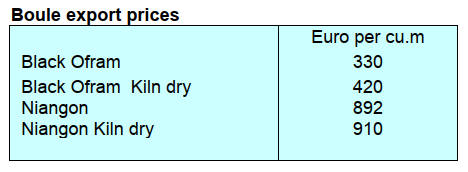
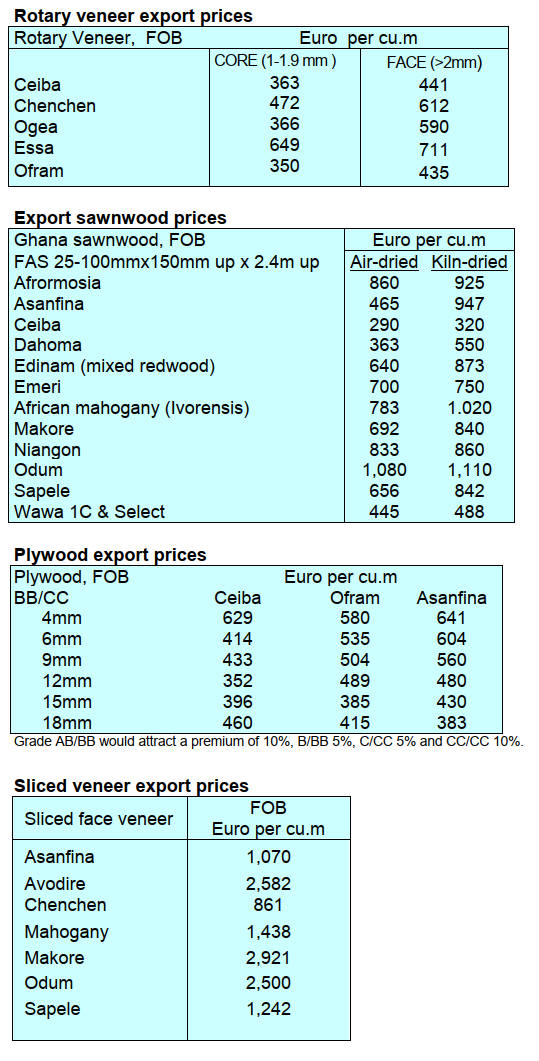
3. MALAYSIA
Removing petrol subsidy could drive up transport
costs
Following Bank Negara Malaysia's decision to maintain
the overnight policy rate at 3% which marks 18 months of
rate pause, economists expect the Bank to leave the
benchmark interest rate unchanged throughout 2025..
The continued monetary policy stance is unlike other
countries in the region which have started to cut rates in
recent weeks. One of the reasons for this is said to be the
current strength of Malaysia's economy. The only possible
negative impact on growth would be a decision to
‘rationalise’ petrol subsidies. Analysts at OCBC Global
Markets Research estimate that, if implemented, retail
prices could rise sharply.
See: https://theedgemalaysia.com/node/733002
Private sector bamboo investment
Pertama Ferroalloys Co Ltd successfully hosted a bamboo
planting programme at its facility in Samalaju, Sarawak in
collaboration with the Sarawak Timber Industry
Development Corporation (STIDC). This initiative is
considered by company representatives as an important
step towards environmental sustainability within the
ferroalloy industry.
Yuki Nakamura, General Manager at Pertama Ferroalloys,
highlighted the reliance on materials such as wood
charcoal and cork but also acknowledged their efforts to
minimise their environmental footprint. Despite producing
220,000 tonnes of ferroalloys annually their commitment
to hydroelectric power allowed them to remain among the
lowest carbon (CO2) emitting ferroalloys producers.
See:
http://theborneopost.pressreader.com/article/281831469243228
In related news, the Vice-Chancellor of Universiti Putra
Malaysia (UPM), Prof. Dr. Ahmad Farhan Mohd Sadullah,
said the Sarawak State government aims to develop 10,000
hectares of commercial bamboo plantations and 2,000
hectares of community bamboo plantation by 2030.
Huge demand for activated carbon
Zainal Abidin Abdullah the General Manager of the
Sarawak Timber Industry Development Corporation
(STIDC) has said there is a huge demand for activated
carbon derived from biomass. He noted that to benefit
from this potential it will be important to develop a strong
framework for biomass research and foster collaboration
among government, industry and academia to enhance
Sarawak’s role in the renewable energy market.
He added that collaborative research between STIDC and
the Forest Research Institute Malaysia (FRIM) showed
that Sarawak’s biomass had excellent properties for
producing energy pellets. In 2023 Sarawak’s export value
for wood pellets reached RM44.474 million, almost
double that of the previous year mainly due to demand in
France, Japan and South Korea.
See: https://www.theborneopost.com/2024/11/07/sarawak-
forestry-corporation-forges-partnership-with-uaes-mubadala-
energy-for-environmental-conservation/
Plywood exports to India
The Ministry of Commerce and Industry India had several
months ago announced that the export of panel products to
India is subject to the Mandatory Bureau of Indian
Standards (BIS) Certification requirements from 28
February 2025. The Malaysian Timber industry Board
(MTIB) has provided information on the Indian Standard.
see:
https://www.mtib.gov.my/index.php/en/announcement/penanggu
han-dan-tarikh-baharu-pelaksanaan-mandatory-indian-standard-
oleh-bureau-of-indian-standards-bis-untuk-eksport-produk-panel-
ke-india
Export update
In the first seven months of 2024 the value of wood
product exports rose 11% year on year on the back of
increased exports of wooden furniture (+14%). Export
earnings from logs, sawnwood and composite panels
declined year on year.
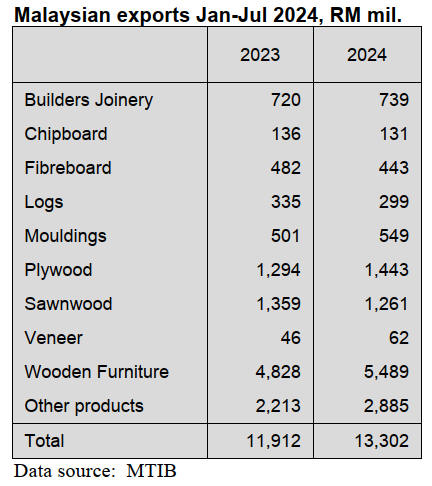
4.
INDONESIA
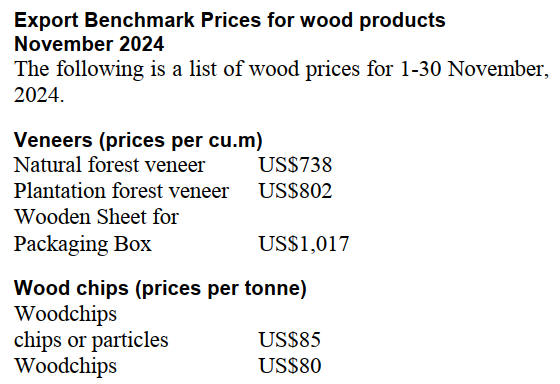
Processed wood (prices per cu.m)
Processed wood products which are leveled on all four
sides so that the surface becomes even and smooth with
the provisions of a cross-sectional area of 1,000 sq.mm to
4,000 sq.mm (ex 4407.11.00 to ex 4407.99.90)
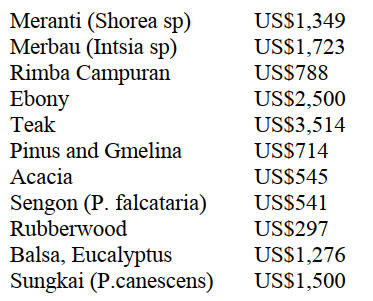
Processed wood products which are leveled on all four
sides so that the surface becomes even and smooth of
Merbau wood with the provisions of a cross-sectional area
of 4,000 sq.mm to 10,000 sq.mm (ex 4407.11.00 to ex
4407.99.90); US$1,500/cu.m.
See: https://forestinsights.id/kemendag-tetapkan-hpe-produk-
kayu-november-2024-harga-patokan-ekspor-kayu-hutan-
tanaman-naik/
Ministry preparing task force to bolster forest
protection
The Minister of Forestry, Raja Juli Antoni, has reported
the ministry is in the process of forming a palm oil task
force to strengthen the supervision and protection of forest
areas.
"Through the task force, we can make an agreement, data
reconciliation, (determine) which data is the most valid,
the maximum fine for state revenue and everything can be
discussed in the task force," he explained. Antoni
informed that he and the Head of the Financial and
Development Supervisory Agency (BPKP), Muhammad
Yusuf Ateh, discussed the plan to form the task force .
In related news, the Minister confirmed his commitment to
implementing the forest protection targets set by President
Prabowo Subianto's initiative. He emphasised that law
enforcement will be a priority.
In a meeting at the Attorney General's Office
strengthening law enforcement in forest protection was
discussed. The minister emphasised that the government
will establish a task force for law enforcement to protect
Indonesia's forests. The prosecutor's office will participate
in this task force.
Attorney General, Sanitiar Burhanuddin, stated that they
openly accepted collaboration as a means of enhancing
inter-institutional coordination. The Attorney General’s
Office has also engaged with various ministries to bolster
law enforcement efforts.
The National Police Chief General Listyo Sigit Prabowo
stated the police and the Ministry of Forestry will
collaborate to ensure the security of Indonesia's forests by
exchanging essential information and data.
See: https://en.antaranews.com/news/332453/ministry-preparing-
task-force-to-bolster-forest-supervision
and
https://www.metrotvnews.com/read/kpLCWdOw-menteri-
kehutanan-temui-jaksa-agung-bahas-penguatan-penindakan-
perusak-hutan
and
https://www.antaranews.com/berita/4441905/kapolri-kemenhut-
bekerja-sama-jaga-hutan-indonesia
Ministry and Armed Forces – co-operation
The Ministry of Forestry and the National Armed Forces
(TNI) Headquarters are planning to sign a memorandum
of understanding which will serve as the basis for
cooperation and collaboration between the two agencies.
The MoU will include cooperation in rehabilitating
damaged forests including replanting deforested areas.
"Considering the limited human resources that we have the
success of the Ministry of Forestry in protecting forests is
very dependent on cooperation and collaboration with the
TNI which has a wide network reaching remote villages,"
said the Minister.
See: https://en.antaranews.com/news/332837/minister-antoni-
seeks-tni-support-to-protect-forests
Opportunity to increase exports to the United States
Some wood product manufacturers are of the opinion that
with the change of government in the US wood product
imports from China may decline presenting an opportunity
for Indonesia to boost its exports.
Abdul Sobur, the General Chairperson of the Indonesian
Furniture and Crafts Association (Himki), stated that
Indonesia has the opportunity to boost its exports to the
US under this condition. However, increasing Indonesian
furniture and craft exports to the US presents challenges.
Indonesia faces competition from countries like Vietnam,
Malaysia, Canada and Mexico, all of which have also
recognised this market opportunity.
Notably, Vietnam stands out as a significant competitor
due to its well-developed infrastructure and proactive
export policies. Another challenge has emerged is the
"America First" initiative which emphasises domestic
products which, said Sobur, may hinder export
opportunities particularly if the US enforces stricter import
regulations. For this reason, Sobur suggested that
Indonesia must take full advantage of export cooperation
agreements such as the Indonesia-Australia
Comprehensive Economic Partnership Agreement (IA-
CEPA).
See: https://industri.kontan.co.id/news/pengusaha-mebel-dalam-
negeri-wanti-wanti-kebijakan-proteksionisme-donald-trump
Encouraging access to the UKM BISA export
programme
The Minister of Trade, Budi Santoso, stated that the
Ministry is working to boost furniture exports and expand
into the global market and this is crucial because furniture
is a key export product of Indonesia.
Consequently, the Ministry of Trade continually supports
the SMEs’ Dare to Innovate, Ready to Adapt to Exports’
(UMKM BISA Export) programme. The UKM BISA
Export programme aims to enhance competitiveness,
innovation and adaptability to global market demands.
“To support the UKM BISA Export initiative, the Ministry
of Trade is working to enhance market access for
Indonesian products in the global market. This effort
includes several actions, such as facilitating business
participation in international product exhibitions, engaging
in trade missions, and leveraging Indonesia's trade
agreements with partner countries" said the Minister.
The Minister stated "business representatives can take
advantage of over 40 trade representatives from the
Ministry of Trade stationed overseas who are responsible
for promoting domestic products,"
Specifically for rattan furniture the Ministry of Trade will
assist rattan furniture SMEs to increase exports. "Our
support will include the creation of unique rattan designs
and prototypes to enhance their acceptance in the global
market as well as opportunities for exhibitions overseas"
said Minister Budi.
See: https://wartaekonomi.co.id/read548337/tinjau-ukm-furnitur-
mendag-ungkap-sejumlah-langkah-dorong-ukm-bisa-ekspor
and
https://www-kemendag-go-id.translate.goog/berita/foto/mendag-
pada-forum-dialog-peningkatan-umkm-bisa-
ekspor?_x_tr_sl=id&_x_tr_tl=en&_x_tr_hl=en&_x_tr_pto=sc
Social Forestry - calls for multi-stakeholder
collaboration
A recent forum urged a better multi-stakeholder
collaboration to engage communities in managing local
forests aligned with Indonesia's climate goals. According
to the Director of the Regional Community Forestry
Training Centre for Asia and the Pacific (RECOFTC)
Indonesia, Gamma Galudra, communities can still make
more use of forest resources to improve their welfare.
He then called for collaboration between social forestry
groups and other stakeholders such as companies, non-
governmental organisations and academia as this can help
pave the way for better management of social forestry
programmes especially in terms of improving human
capital and institutional capacity as well as developing
business aspects.
See: https://jakartaglobe.id/special-updates/social-forestry-calls-
for-multistakeholder-collaboration
and
https://investor.id/national/379608/kolaborasi-multipihak-untuk-
tata-kelola-perhutanan-sosial
Innovative funding to support conservation activities
The Indonesian government is in the process of preparing
a regulation that will allow for funding innovations aimed
at supporting conservation activities as part of the Law on
Conservation of Biological Natural Resources and
Ecosystems (KSDAHE). Satyawan Pudyatmoko, the
Director General of Natural Resources and Ecosystem
Conservation (KSDAE) at the Ministry of Forestry stated
that there is a significant funding gap for biodiversity
management.
He highlighted that an estimated Rp33.6 trillion is needed
annually but the available funds amount to only Rp10.2
trillion, which includes allocations from the State Budget.
He mentioned that there is potential funding, including
grants from various international sources in line with the
global commitments.
See: https://www.antaranews.com/berita/4444033/kemenhut-
siapkan-aturan-inovasi-pendanaan-dukung-kegiatan-konservasi
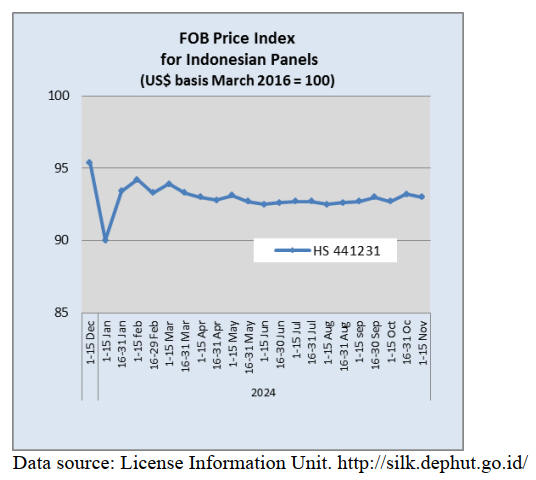
5.
MYANMAR
Yangon’s population increases – house rents surge
The conflict in Myanmar is driving up housing demand in
Yangon. Residential property rents have soared and home
prices have risen as people in remote border regions seek
the relative safety of the city. The United Nations’ refugee
agency estimates that some 3 million people have been
displaced by fighting.
It has been estimated that Yangon’s population has risen
from around 5.5 million to as high as 10 million leading to
a shortage of housing
See: https://www.rfa.org/english/news/myanmar/myanmar-
yangon-real-estate-price-increase-10182024144056.html
Agriculture faces mounting challenges
Agriculture remains a critical pillar for Myanmar’s
economy providing livelihoods and food security for
millions. After a strong recovery in 2023, when agriculture
emerged as Myanmar’s best-performing economic sector
with a 2% growth, the sector is facing new and worsening
challenges. These include labor shortages driven by
conscription-linked migration, price controls on farm
products, suspension of agricultural loans and the fighting.
This situation has been made worse by the severe flooding
in September.
The UN Development Programme (UNDP) warns that a
combination of restricted trade, declining food production
and intensified conflict has created a “perfect storm” that
threatens to plunge the region into severe food insecurity.
A press release from the UNDP highlights the dwindling
human capital saying “the conflict and economic strife are
accelerating the degradation of Myanmar’s human capital.
Essential services like healthcare, education and access to
clean water and sanitation are becoming luxuries out of
reach for many with nearly 25% of children no longer
attending school. The healthcare systems are strained to
breaking point”.
The UNDP statement continues “a mass exodus of skilled
workers is depleting the nation’s productive capacity,
exacerbating the long-term effects of this crisis.”
See https://www.undp.org/asia-pacific/publications/rakhine-a-
famine-in-the-making
and
https://news.un.org/en/story/2024/11/1156676
6.
INDIA
Wood based panel price
increase push up index
The annual rate of inflation based on the India Wholesale
Price Index (WPI) was 1.84% for September 2024. The
positive rate of inflation in September was primarily due
to increase in prices of food and food products, other
manufacturing, motor vehicles, trailers and semi-trailers
and machinery & equipment.
Out of the 22 NIC two-digit groups for manufactured
products 10 groups witnessed an increase in prices, 9
groups witnessed a decrease in prices and 3 groups
witnessed no change.
Some of the important groups that showed month on
month increase in prices were food products, other
manufacturing, other non-metallic mineral products,
computers and electronics, optical products and clothes.
The WPI for woodbased panels continued to rise as did the
WPI for sawnwood but the price index for veneers
declined marking two consecutive monthly drops.
Some of the groups that witnessed a decrease in prices
were basic metals, textiles, motor vehicles, trailers and
semi-trailers, chemicals and chemical products and
fabricated metal products.
See: https://eaindustry.nic.in/pdf_files/cmonthly.pdf

Pine logs accepted for plywood core veneer
production
The correspondent reports that the switch to pine log
peeling for the production of plywood core veneer has
emerged as a survivor for this sector. Reports says that
after successful trials in Kandla based plywood mills pine
logs are now utilised in North India plywood mills.
The Indian plywood industry has been struggling due to
the high prices of plantation poplar and eucalyptus where
prices reached an all-time high in 2024. The impact of the
surge in prices resulted in some mills in North India either
reducing production or even closing mills.
It is understood that MDF manufacturing units are also
considering the use of the lower priced pine as a raw
material option.
In the past plywood sector observers suggested that few
mills would utilise pine logs for plywood manufacturing
but nowadays pine is being used but unfortunately some
people are resisting the change away from the convention
of using eucalyptus and poplar but recently pine logs are
being sold in greater volumes.
It has been observed that pine logs have started to be used
in mills in the Delhi-NCR area and in states of Yamuna
Nagar, Uttar Pradesh and Punjab.
Manufacturers welcome the change to pine as this helps
check the rising production costs which have been driven
up by the high prices of poplar logs which, in part, reflects
declining availability. Manufacturers are becoming more
confident as the issue of log supplies has eased and pine
wood for core veneer is gaining acceptance. There is also
an advantage in that plywood with a pine core is lighter
weight and the yield of veneers is higher with pine logs.
Plywood from Vietnam
The October Ply-Reporter magazine has an article
discussing the rise in orders for plywood placed by Indian
imports with manufacturers in Vietnam as reflected in the
arrival in India of 1,500 containers of plywood in
September. It is reported that as many as 2,500 containers
of plywood could be arriving in India before year end.
See: https://www.facebook.com/plyreporter/photos/welcome-to-
the-october-2024-issue-which-contains-lots-of-market-reports-
industry/1067838062012350/?_rdr
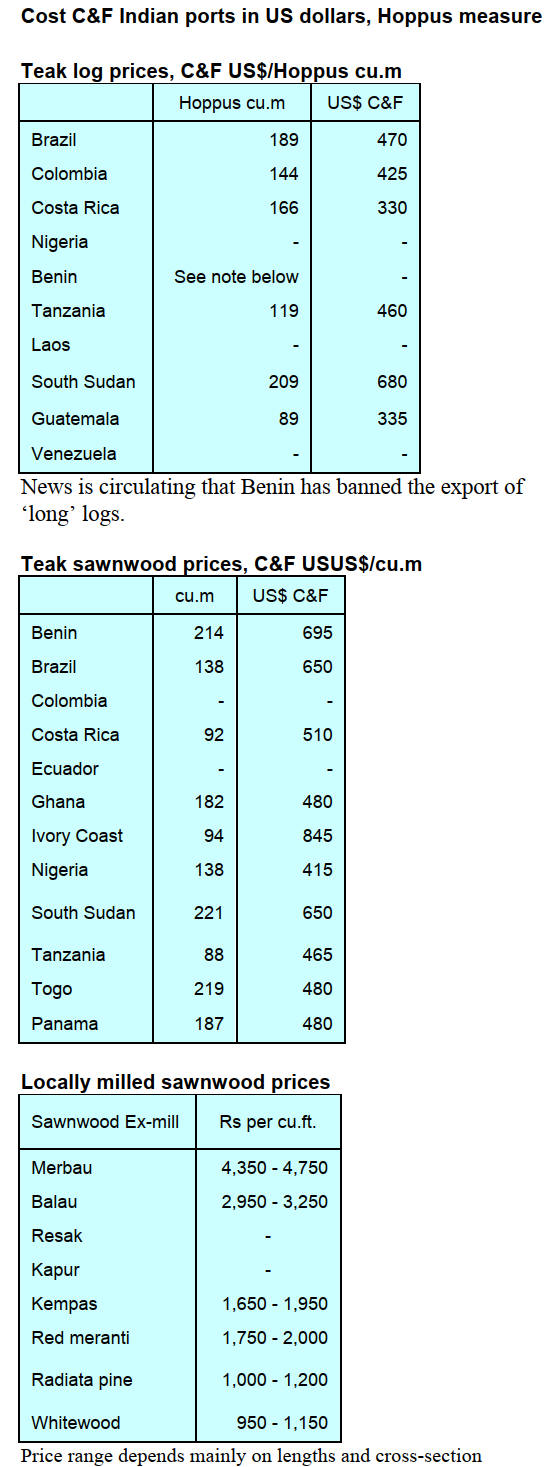
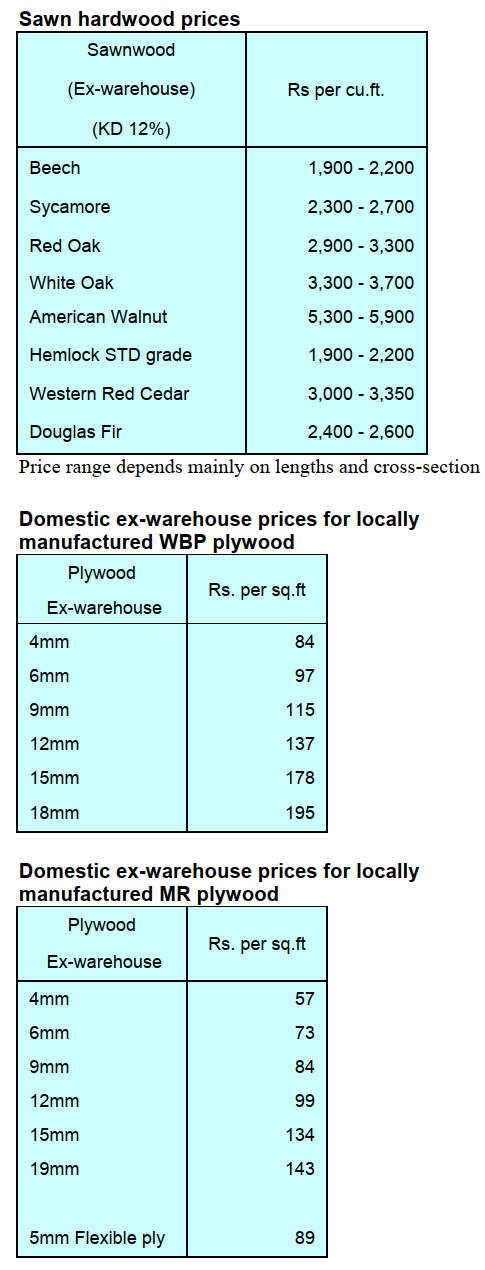
7.
VIETNAM
Wood and wood product (W&WP) trade
highlights
According to the General Department of Customs,
W&WP exports in October 2024 reached US$1.5 billion,
up 20% compared to September 2024 and up 17%
compared to October 203. Of the total WP exports fetched
US$1.01 billion, up 12% compared to September 2024
and up 15% compared to October 2023.
In the first 10 months of 2024, the W&WP exports
reached US$13.2 billion, up 21% over the same period in
2023 of which WP exports alone contributed US$9.05
billion, up 23% over the same period in 203.
W&WP exports to Japan in October 2024 amounted to
US$148 million, up 20% compared to the previous month
and up 10% compared to October 2023. In the first 10
months of 2024 W&WP exports to the Japan were to
US$1.4 billion, up 1% over the same period in 2023.
In October 2024 exports of kitchen furniture were valued
at US$129 million, up 20% compared to the previous
month and up 10% compared to October 2023. In the first
10 months of 2024 exports of kitchen furniture reached
US$1.16 billion up 25% over the same period in 2023.
Vietnam's W&WP imports in October 2024 cost US$250
million, up 7% compared to September 2024 and up 40%
compared to October 2023. In the first 10 months of 2024
Vietnam spent US$2.28 billion for W&WP imports, up
28% over the same period in 2023.
NTFP exports in September 2024 decreased for the 3rd
consecutive month, reaching US$50.44 million, down
25% compared to August 2024 and down 5% over the
same period in 2023. In the first 9 months of 2024 NTFP
exports accounted for US$594.80 million, up 10% over
the same period in 2023.
Vietnamese wooden furniture in the US
Vietnamese wooden furniture is bolstering its export value
and market share in the US wooden furniture market as
imports. According to the US International Trade
Commission the importation of wooden furniture into the US
during the first eight months of 2024 amounted to US$13.8
billion, a 5.6% increase from the same period in 2023.
Vietnamese wooden furniture exports to the US were
US$5.6 billion in the first eight months and accounted for
around 40% of the total US import value for wooden
furniture.
The interest of American consumers in products from
Vietnam is indicative of the increase in value and market
share of Vietnamese wooden furniture.
As the US housing market recovers it is anticipated that
US wooden furniture imports will continue to increase. As
the Federal Reserve commences to reduce interest rates it
is probable that home loan rates will continue to fall which
will stimulate home sales and, as a result, stimulate the
demand for wooden furniture.
The Institute for Supply Management (ISM) has reported
that US inventory levels are declining at the quickest rate
in 2024, indicating that manufacturers are maintaining low
inventory levels.
The positive growth trajectory of Vietnam's W&WP
exports to the US is anticipated to be bolstered by this
favorable supply-demand factor in the final months of
2024.
However, the US imposes trade protection measures on
Vietnamese exports. The intensity of domestic competition
for US industries is on the rise as a result of the increased
imports.
In this context it is probable that US companies will
intensify their utilisation of trade instruments in order to
mitigate competitive pressures. Consequently, the
Vietnamese wood industry must exercise caution and
establish close relationships with the Vietnamese Trade
Office abroad and the Trade Remedies Authority (Ministry
of Industry and Trade) in order to receive early warnings
of trade protection investigations. This allows for the
implementation of proactive strategies to maintain market
share in critical markets.
Vietnam is one of the three largest net exporters to the US
according to Mr. Do Ngoc Hung, the Head of the
Vietnamese Trade Office in the US. Consequently,
Vietnam is perpetually "on the radar" of US trade defense
activities.
There is a trend towards increased trade protection
activities. In these instances US authorities prioritise the
protection of domestic companies.
Mr. Hung recommends that exporters to the US remain
prepared to address prospective litigation filed in the US
against their export products. This entails striving to
achieve the most favorable outcome possible by
maintaining close collaboration with the Ministry of
Industry and Trade and the Vietnamese Trade Office in the
US to provide the investigating authorities with
comprehensive and expeditious information.
Vietnam's wood industry sector aims to export US$15.2
billion worth of its products this year, an increase from
US$14.47 billion last year.
Since the slowdown in 2023 from the beginning of this
year W&WP associations and enterprises have been
proactive in production and seeking export markets.
A series of market exploration fairs were held attracting
customer interest in Vietnamese wood products in key
production areas, including Ho Chi Minh City and Binh
Dinh and Binh Duong Provinces.
See: https://vietnamagriculture.nongnghiep.vn/the-market-share-of-
vietnamese-wood-furniture-in-the-united-states-expanded-
d408363.html
Vietnam’s ambitious forestry master plan
Decree No. 895/QD-TTg of 24 August 2024 presents a
master plan for the sustainable development of the forestry
sector. Key objectives encompass the conservation,
cultivation and enhancement of forest resources and land.
The focus of this planning extends to forested lands as well
as those earmarked for afforestation and forestry
infrastructure such as plant nurseries, ranger stations and
timber transport routes.
Minister of Agriculture and Rural Development, Le Minh
Hoan, underscored the pivotal role of this master plan in
unlocking the forest's potential to contribute to socio-
economic growth, environmental protection and climate
change mitigation.
Director Tran Quang Bao of the Forestry Department stated
that the 2021-2030 National Forestry Master Plan with a
vision to 2050 constitutes a significant stride in the
implementation of the Planning Law and the Forestry Law.
Specific objectives of the plan include:
maintaining a forest cover ranging from 42-43
percent nationwide
augmenting the quality of natural forests
achieving a 5-to-5.5 percent annual growth rate in
forestry production value
Moreover, the planning sets forth targets to double the
income derived from commercial plantations by 2030
compared to 2020 with projected timber and forest product
exports reaching US$20 billion in 2025 and US$25 billion in
2030.
According to Director Tran Quang Bao, the plan also
outlines a target of a 5% annual increase in forest
environmental services reaching approximately VND4
trillion (US$161 million) per annum during the 2026-2030
period.
Key strategies encompass the transfer of advanced forestry
technologies, the formulation of sustainable forest
management plans and the provision of livelihood support to
communities adjacent to special-use forests.
The total estimated investment for the plan through 2030 is
approximately VND217.3 trillion (US$8.7 billion), sourced
from both the state budget and other channels.
See: https://en.sggp.org.vn/vietnam-unveils-ambitious-forestry-
master-planning-post113030.html
Remove bottlenecks in the wood supply chain
The legal origin of wood products is one of the most
essential requirements for Vietnam's two main export
markets, the US and the EU. This is considered a vital
factor for export enterprises.
According to a survey by the Forest Trends research group
led by To Xuan Phuc, wood raw materials in Vietnam
come from: domestically planted wood (acacia,
eucalyptus, and rubberwood), wood from domestic
farms/gardens, imports of plantation and natural forest
species. It is acknowledged that many wood products in
the group of bedroom furniture, office furniture, kitchen
and wooden furniture parts exported to the EU are
processed wood grown on areas that were previously
natural forests but converted to rubber plantations.
When using this wood source businesses face challenges
in traceability and transparency and accountability
especially the requirement to clearly state the names of all
types of wood used in exported products. Another factor
pointed out by Phuc is evidence related to the legality of
raw material sources, including species names and
commercial details. Some countries also require other
evidence, such as forest product lists, raw wood purchase
invoices or logging licenses.
See: https://vietnamagriculture.nongnghiep.vn/remove-the-
bottlenecks-in-the-wood-industry-supply-chain-d406028.html
8. BRAIL
Bank and Forest Service partnership for
Amazon
restoration
The Brazilian Development Bank (BNDES) and the
Brazilian Forest Service (SFB) within the Ministry of the
Environment and Climate Change recently signed a
contract to develop new forest concession projects. The
contract covers 11 conservation units with a total area of 6
million hectares.
The aim is to introduce sustainable forest management
over 1.4 million hectares and restore 334,000 hectares of
degraded forests.
BNDES is leading the financial modeling while the SFB is
conducting forest inventory and social studies with the
resources provided by the Inter-American Development
Bank (IDB). It is estimated that the structuring studies in
these 11 conservation units will be conducted in stages
enabling the call for concession in 2026.
The forest concession process includes technical
modeling, public consultations with local communities and
project evaluation to ensure sustainable forest use and
respect for social rights is included in the management
plan. The contract between BNDES and SFB covers areas
across five Amazonian states (Pará, Roraima, Amazonas,
Rondônia and Mato Grosso) and involves sustainable
forest management projects in several national forests and
conservation areas.
See: https://forestnews.com.br/bndes-e-servico-florestal-
estruturam-concessao-de-11-unidades-de-conservacao/
Traceability - key to verifying sustainability in natural
forests
The 3rd event “Sustainable Timber: the future of the
market” held in the State of Minas Gerais organised by the
National Forum for Forest-Based Activities (FNBF) and
the Center of Timber Producing and Exporting Industry of
Mato Grosso (CIPEM-MT) highlighted the sustainable
forest sector in the State of Mato Grosso in the Amazon
region.
Trade in timber from natural forests in the Minas Gerais
State up to October rose around 40% year on year and
involved about 100 native timber species.
As of October around 71,944 cu.m of timber from Mato
Grosso State were sold to companies in Minas Gerais
generating approximately R$69.6 million, 40% more than
in the same period in 2023.
The market event covered topics such as traceability and
sustainability in the production chain with the use of the
Sisflora 2.0 system which provides monitoring and control
throughout the entire production chain. This system
enables traceability from the origin to the final point of
sale as each log is tracked with precision.
Traceability and chain of custody were also emphasised as
mechanisms to ensure transparency and environmental
control meeting the standards required in both national and
international markets while promoting the preservation of
the Amazon forest.
See: https://www.cenariomt.com.br/mato-grosso/rastreabilidade-
na-producao-sustentavel-de-madeira-nativa-em-mato-grosso-e-
abordada-em-evento-nacional/
Brazil renews partnership with BM Certification
ABIMCI (Brazilian Association of Mechanically
Processed Timber Industry) has renewed its partnership
with BM Certification (a certification body) ensuring the
continuity of the CE Marking and UKCA Marking (UK
Conformity Assessment) for the Brazilian plywood sector.
This certification verifies that a company maintains
standardisation in its products, production processes and
quality allowing certified wood products to be marketed in
27 European Union countries (CE Marking) and in the
United Kingdom (UKCA).
In addition to international certifications, ABIMCI offers
its members technical support and Sectoral Quality
Programs (PSQ) focused on the domestic market, such as
the PSQ-PME for Wooden Doors and the PSQ for Film-
faced Plywood and it plans to launch a new quality and
certification programme for pallets.
To further strengthen these technical initiatives ABIMCI
offers the National Timber Quality Program (PNQM) a
quality management tool that provides a framework for
standardisation and quality control throughout the
production process. The Tool also contributes to optimise
production, reducing costs and facilitate the attainment of
both national and international certification. ABIMCI also
coordinates the Brazilian Timber Committee (CB-031) of
the Brazilian Association of Technical Standards (ABNT)
which defines standards for wood products in Brazil.
See: https://abimci.com.br/abimci-renova-parceria-com-bm-
certification-para-certificacoes-internacionais-ce-e-ukca/
Importance of certification and sustainable trade
The Institute of Agricultural and Forest Management and
Certification (Imaflora) participated in the FSC ‘Amazon
Business Meeting’ in Belém which focused on the
sustainable timber trade and analysing the role of forest
management and certification in building a responsible
value chain.
The event covered topics such as the potential impact of
the EUDR which requires strict traceability for forest
products and the adaptations by FSC to ensure compliance
with the new requirements.
Imaflora emphasised the role of FSC certification in
verifing supply chains. The Brazilian Trade and
Investment Promotion Agency (ApexBrasil) presented a
market analysis of tropical timber, highlighting that in
2023 the sector generated around US$310 million.
Brazilian exporters face trade barriers that hinder their
competitiveness. International demand for tropical timber,
especially from the United States and Europe is high, but
environmental requirements pose compliance challenges.
The event emphasised the need to modernise the forest
sector, promote responsible practices and increase demand
for certified timber which, in addition to being
environmentally friendly, should be promoted as the top
choice for consumers. To ensure forest sustainability
collaboration among producers, certifiers and regulatory
bodies was highlighted as essential.
See: https://www.imaflora.org/noticia/imaflora-participa-de-
discussao-sobre-comercio-sustentavel-e-certificacao-no-fsc-
amazon-business-encounter
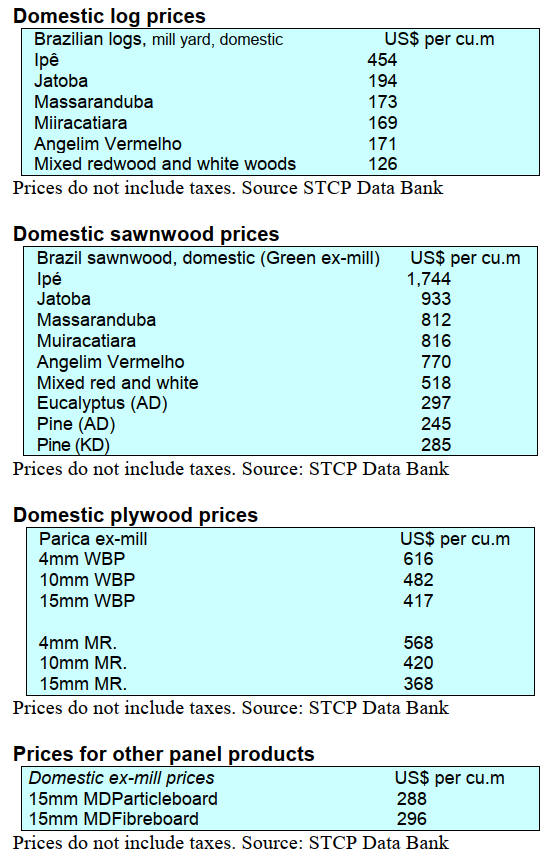
Export prices
Average FOB prices Belém/PA, Paranaguá/PR,
Navegantes/SC and Itajaí/SC Ports.

9. PERU
Tools to identify forest
species in the Peruvian
Amazon
The National Forest and Wildlife Service (SERFOR), in
coordination with the Center for Productive Innovation
and Technology Transfer of Wood (CITEmadera), held an
event to present “Tools for the identification of forest
species and their contribution to the sustainable
management of forest resources” and the second edition of
the “Manual for the anatomical identification of wood
from forest species in the Peruvian Amazon” was
presented.
At the same time, manuals for the botanical identification
of forest species in the Peruvian Amazon Vol. I and Vol 2,
and the booklet for identification of Dipteryx
(shihuahuaco) and Handroanthus (tahuarí) in the Peruvian
Amazon were introduced.
Recently developed applications were presented:
IDmaderas
https://x.com/UNODC_ENV/status/176323542880160173
7
MaderApp
https://envol-vert.org/en/fd/envol-vert-and-maderapp-as-
part-of-research-to-protect-amazonian-forests/
and
IDÁrbol
https://conexionambiental.pe/id-arbol-nueva-plataforma-
que-permitira-reconocer-especies-forestales-maderables-
de-nuestros-bosques/
Experts pointed out that the information and application
presented will help in the identification of what type of
wood is being sold and obtain evidence that can support
the work of the Attorney General's Office when it is
required to intervene in relation to the illegal trade of
forest products.
Sylvia Reategui García, Senior Advisor to ProAmbiente
stated that "there are almost 240 species that have been
listed in the manuals (for botanical identification of forest
species in the Peruvian Amazon) which includes joint
work between academia and various actors to promote
legal management of wood, hand in hand with a market
that demands legality”.
Gino Catturini Ruiz, Director of CITEmadera Lima, stated
that "the manual (for the anatomical identification of wood
from forest species in the Peruvian Amazon) can be used
by all users of the forest to take advantage of the potential
we have in the country and continue promoting scientific
research in the country”.
See: https://www.gob.pe/institucion/serfor/noticias/1054119-
serfor-y-citemadera-lima-presentaron-herramientas-para-
identificar-especies-forestales-de-la-amazonia-peruana
International Forum on ‘Commercial Forest
Plantations’
The National Forest and Wildlife Service and its
Sustainable Productive Forests Programme hosted an
International Forum on Commercial Forest Plantations
within the framework of the National Forest Week 2024
which brought together leading specialists from Peru,
Chile, Brazil, Argentina and Costa Rica.
One of the goals of the forum was to promote the
exchange of knowledge, experiences and best practices in
the sustainable management of commercial forest
plantations.
The head of the Plantations Project in SERFOR’s
Sustainable Productive Forests Programme said that in the
Cajamarca Region there are approximately 60,000
hectares established which will supply wood for the
domestic market.
See: https://www.gob.pe/institucion/serfor/noticias/1054384-
cajamarca-serfor-realiza-foro-internacional-de-plantaciones-
forestales-comerciales
Native communities trained
With the aim of promoting the sustainable use of forest
resources in native communities in the Peruvian Amazon
the Agency for the Supervision of Forest and Wildlife
Resources (OSINFOR) trained 34 members of native
communities in Ucayali on their rights and obligations as
holders of enabling forest titles.The attendees strengthened
their knowledge about the obligations of holding forest
titles, wood cubing(measurement) and completing
registrations in the Book of Operations.
The training included measurement of standing and round
timber, essential techniques for keeping a precise control
of the resources used, respecting the management plans
approved by the Administraciones Técnicas Forestal y de
Fauna Silvestre (ARFFS) and technically supported by
SERFOR.
In field work the participants applied what they had
learned in an exercise measuring standing trees, the data of
which will be used to update the forest censuses of their
management plans. In addition, they carried out the
measurement of round timber, an essential practice to
complete the record in the Operations Book.
See: https://www.gob.pe/institucion/osinfor/noticias/1056289-el-
osinfor-capacita-a-comunidades-nativas-en-ucayali-sobre-los-
titulos-habilitantes-y-la-cubicacion-de-madera
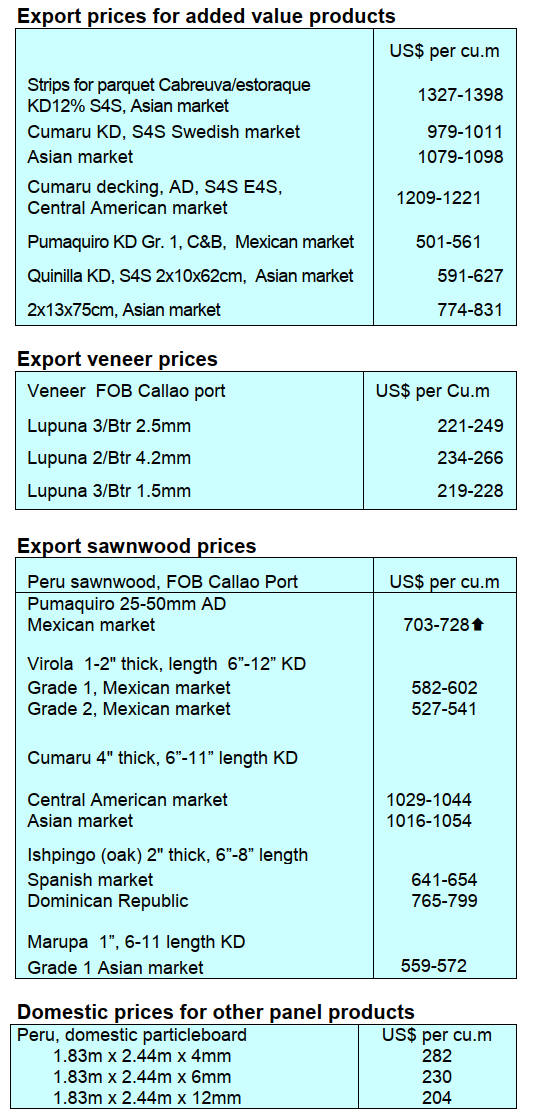
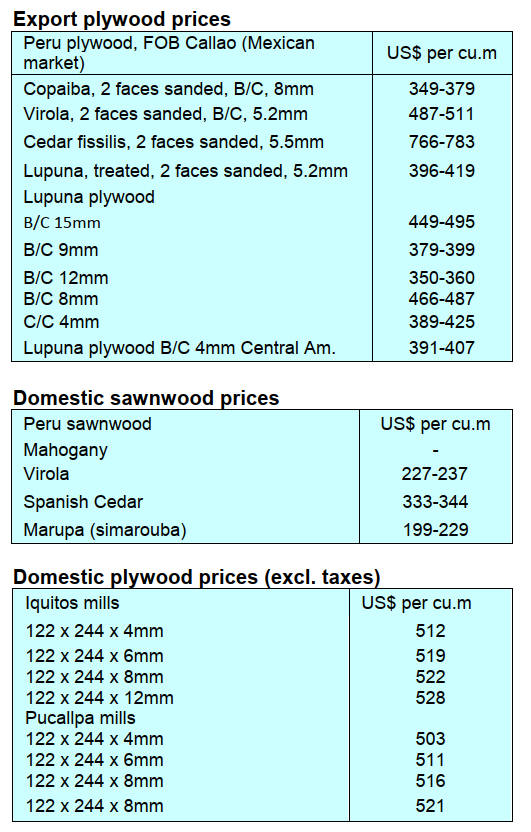
|